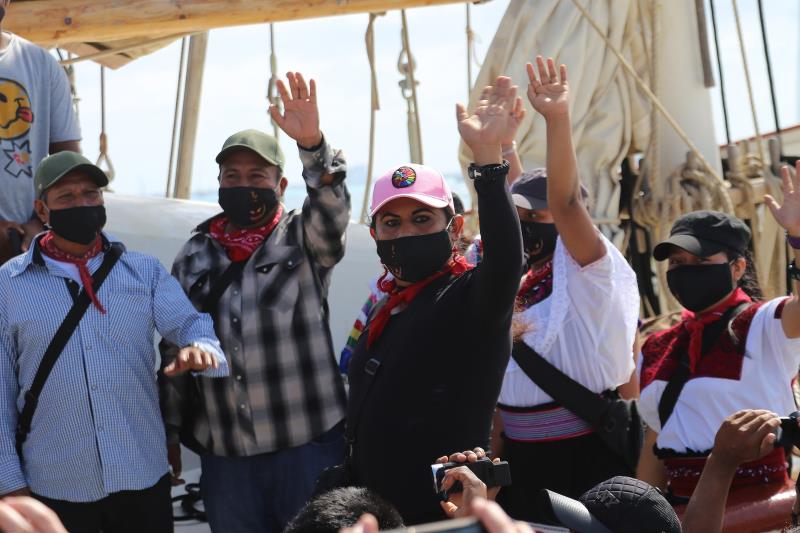RIO DE JANEIRO, BRAZIL – The seven-member delegation of the EZLN (Zapatista Army of National Liberation) “Squadron 421” set sail on Sunday aboard the German-flagged ship “La Montaña” from Isla Mujeres, in the state of Quintana Roo, Mexican Caribbean, and hopes to dock at the port of Vigo, Spain, in June.
They will then begin a tour of over 20 European countries, where they were invited by different European organizations and NGOs with the goal of exchanging ideas on how to tackle “the inequality caused by the capitalist economic and social system.”

The expedition, called “Travesía Por La Vida. Capítulo Europa” (Crossing For Life. Europe Chapter), was scheduled to set off from Isla Mujeres on May 3rd, but the event’s organizers said they were forced to bring it forward due to changes in weather conditions in the area.
Before reaching Isla Mujeres, the Zapatista caravan traveled nearly 1,000 kilometers from their home state of Chiapas, which they left last Monday, stopping in the state of Yucatán to meet with indigenous groups.
The seven members of the Zapatista delegation – 4 women, 2 men and 1 LGBT community representative, hence Squadron 421 – boarded “La Montaña” last Friday; part of the indigenous delegation that traveled with them joined them on the boat during those days, but today disembarked with all their belongings. The 7 members are joined by 5 sailors as crew, from Germany and Colombia.
As the ship set sail, from the dock where the Zapatista delegation was seen off, deputy commander Moisés spoke about the purpose of the trip.
AWAKENING
“We are going to awaken people, we know that capitalism has invaded us in the world and we know that there is someone in Europe and we can understand each other, that is why we are going,” he said.
“The greatest challenge is the struggle for life, because if we do not organize ourselves, women and men, both from the countryside and the city, they will destroy us and capitalism will destroy us, those who do not respect Mother Nature, we have not harmed Mother Earth, capitalism has,” added Moisés.
“I am not going to talk about Mexico because capitalism is not only there, capitalism is in the world, in Mexico we already know how it is, we want to know more about how the other worlds are, we want to listen, we want to share, to know how they are, to learn, because capitalism has different ways of controlling us,” he said.
The Zapatista leader said that this tour is to “plant life” and intends to awaken the people of the countryside and the big cities.
“Life belongs to mother earth and we all have to fight, we have to organize and defend it, but all together, both from the countryside and the city because from mother earth comes everything we eat, even if they are in the city, even if they live on 30 or 40 floors, we live from the air, oxygen and water, we live from food,” he said.
On Sunday, members of the National Indigenous Council and representatives of Human Rights organizations reached the dock where “La Montaña” was anchored and closely watched the caravan that accompanied the delegation.
EZLN’S ORIGINS
The current Zapatista movement emerged on January 1st, 1994 in the southern state of Chiapas with the uprising of a group of armed indigenous people led by deputy commander Marcos.
The EZLN was unveiled on the very same day that the North American Free Trade Agreement (NAFTA), signed by Canada, the United States and Mexico, came into force.
As a guerrilla group, the Zapatistas intended to fight against then Mexican President Carlos Salinas de Gortari (1988-1994). In 1996, however, it was converted into a political movement. As such, the Zapatistas are now very critical of President Andrés Manuel López Obrador, and with the trip to Europe they intend to make know their demands for greater autonomy for Chiapas state within the Mexican federal structure.

